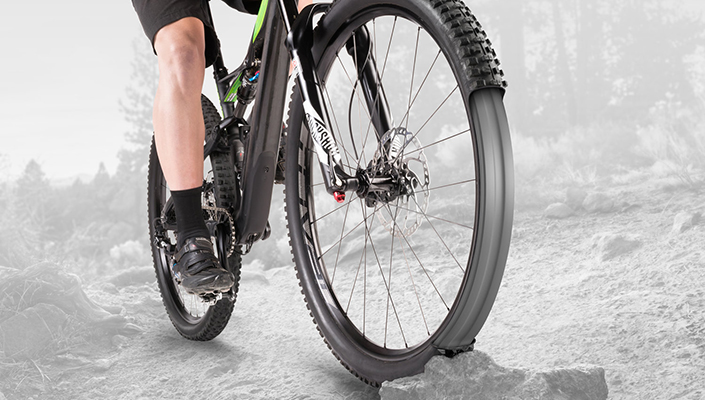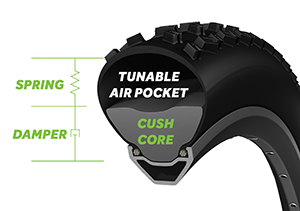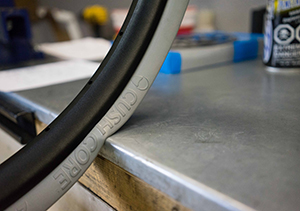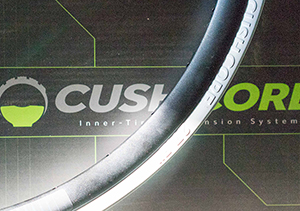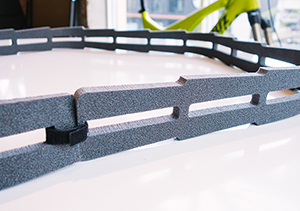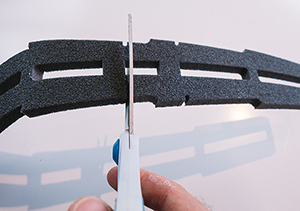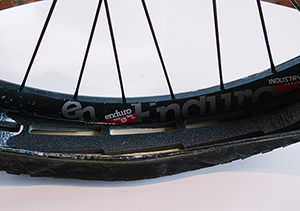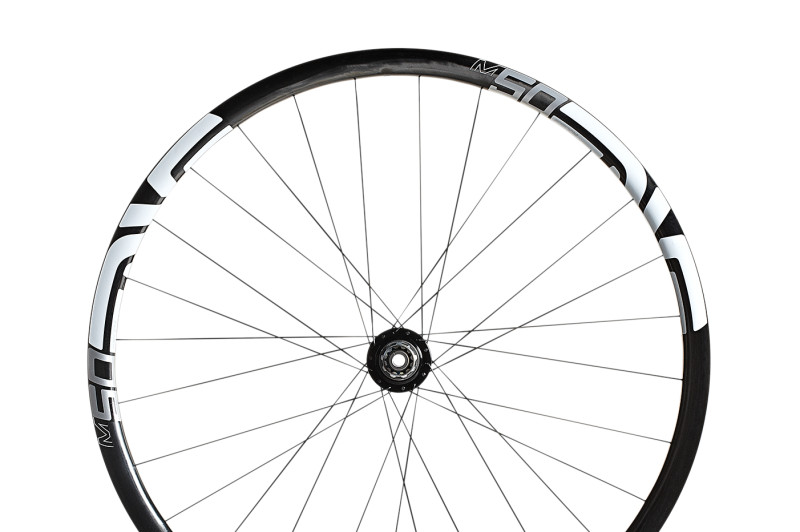
One of the more surprising and useful products introduced to the market in recent years is the humble foam tire insert. A simple solution to a few age old cycling problems, the main one being the pesky pinch flat. The basic idea behind these products are to stop your tire from bottoming out on your rim during an abrupt impact, like with a curb or a rock or if you land hard off a drop or jump. An insert is meant to absorb the impact before getting to your rim. It can also act like secondary suspension, complementing your front fork and rear shock.
The premise of foam tire inserts is simple enough, but how do they actually work? Are foam tire inserts the future? Or will wheel manufacturers simply adapt their products? We set out to test two of the more popular foam tire insert systems on the market to answer our questions.
First, let's get a little more in depth about why you might want to ride with foam tire inserts.
What's the deal with foam tire inserts?
Some of you reading this may have picked out one big issue in the first paragraph, some of you may not, but it does require clarification. If you’re asking, “Tire inserts to prevent pinch flats? If they need to be installed into my tires how are they going to work with my tubes?” It’s simple: they don't.
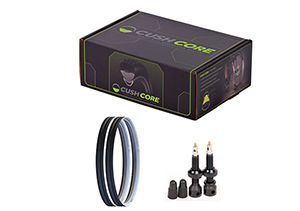
Foam tire inserts are meant to be run with tubeless set ups only, and the use of 'pinch-flat protection' as one of the main benefits is not quite accurate. Keep in mind it’s not the manufacturers that are making this claim, it’s just one of the terms being used when describing and writing about tire inserts. Still, a very substantial impact on a tubeless set-up may in fact slice open your tire, and likely damage your rim at the same time. The main reasons to run tire inserts are for dampening, rim protection, and tire stability.
Here's an impact demonstration video by Cush Core:
Foam tire inserts are meant to improve ride/traction/safety of your ride in a reasonable and affordable manner. If you run a tubeless setup, then you may be aware of tire burp – when you unseat the bead while cornering hard. Your tires may release from a little to almost all of their air depending on how badly they burp. Foam tire inserts are meant to support the sidewalls of your tires while allowing your tread to articulate according to the terrain they are in contact with. This only works if your tire is inflated to the right pressure to compensate for the reduction in volume due to the insert. If you think of foam inserts as suspension, then what’s happening is you’re adding a volume reducer to increase the progressive rate of your suspension. The lower pressure will allow it to run soft and supple, yet it will ramp up quickly under impact.
If you run carbon rims, then the impact protection may be your best friend as it can save your expensive rims from destruction via rock garden.
Cush Core
Labeled as an ‘Inner Tire Suspension System’ Cush Core is designed to absorb impacts as well as to stiffen and strengthen your tires. Installation of Cush Core is difficult enough that once installed you will not want to take them out again (see next). That’s all fine if they do what they’re promising.
Cush Core has a reputation of being difficult to install and usually requires two people – stretching a tire over the inserts can be laborious. However, if you install and un-install the product a few times, you will for sure streamline the process significantly. For your first install, be prepared for a battle. Installing the first bead of your tire over top of the Cush Core is relatively easy, but when it comes to the second bead, that’s where you’ll want a second set of hands. Grab a buddy and go – you need to move the Cush Core out of the way of the bead with one set of hands while forcing the tire bead into place with the other. It’s a battle yes, but it can be done and the results are worth it.
Surprisingly enough, riding with Cush Core inserts is quite noticeable right away. There is a deadening to the ride as the reduced volume and PSI absorb a decent amount of impact. If you lift your bike off the ground and drop it you’ll notice the subtle lack of bounce and quieter sound compared to a regular tubeless set up. On the trail this is noticeable by the first root or rock. Much like it is promoted, the ride of Cush Core is a more deadened and controlled one. Without a doubt, I could feel the foam insert rattle and bang off sharp rocks and roots with no issue to my tires or rims at all, and I had no burping while cornering. Is it life changing? No, but does the product do what it claims? Yes, without a doubt it does.
Huck Norris
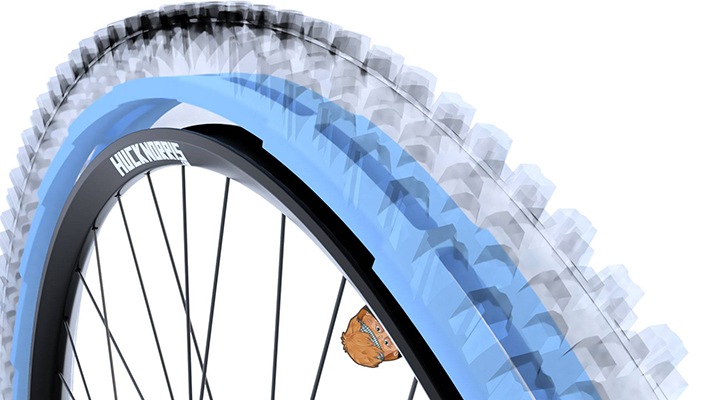
The cleverly named Huck Norris system is the brain child of Finnish innovation and has its own way of tackling tire bottom-out problems. The thinner strips of foam sit inside of the tire rather than around the rim like a rim strip. The foam inserts support the sidewalls in hard cornering and don’t allow the tire to bottom out on the rim from rough impacts, as they simply get in the way and absorb the impact. The system comes in two basic sizes/densities, XC and DH, with the DH being more heavy duty for obvious reasons. The system comes cut-to-fit for 26/27.5/29-inch wheel sizes, with 3 rim width options (21-26mm, 26-35mm, 34-45mm) adding to its ease of use and universal appeal. This system is a breeze to install as you simply place it in your tire and then install your tire like you normally would.
A good friend and lifetime MTB rider Kent Toth took the Huck Norris system for a ride. He reported the more deadened feeling you get with Cush Core wasn’t quite there with the Huck Norris. The product was easy enough to install with modern wider rims, yet it was noticed that the product felt somewhat archaic, like a 1990’s DIY fix for a 2017 problem. You can run regular or slightly lower pressure with Huck Norris; Kent chose the latter so he could take advantage of the better grip. Nonetheless, and in spite of Huck Norris feeling old-fashioned, did it do what it promised it would? Yes, yes it did. Kent confirmed when his tire would bottom out, like on a rock, that Huck Norris was there to absorb some of the impact and sparing his rim. And yes, the slightly lower tire pressure increased grip, but it did come at the expense of a slower climbing pace, which isn't Huck Norris' fault.
FTW or for the bin?
Do foam tire inserts work? Yes-ish. Cush Core works better than Huck Norris, but Cush Core is over twice the price and weight. Both systems accomplish pretty much everything they claim, but that doesn’t solidify their positions in the world of must-ride bike accessories. The run flat capabilities of both are pretty promising as the inserts will allow you to safely ride out on a completely deflated tire. The claim by both companies that you can now run XC tires instead of DH ones is a little bit of a stretch as there are a myriad of reasons why you run DH-specific tires.
Enter the newly redesigned ENVE M-series of carbon wheels. ENVE set out to solve the pinch flat issue by redesigning their hookless beads to make them wider and stronger, which limits the chance of the bead cutting through the tire during an impact. Now, I know this is sounding like a crazy upsell – $80 for foam inserts versus $800 for carbon rims, but hear me out.
The take away from this is that rim manufacturers like ENVE are understanding that their wheels need to adapt, and that ride quality can be increased in doing so. A teeth-shatteringly stiff set of gen 1 ENVE 50 hoops will for sure benefit from the addition of a foam tire insert. The inserts will tame the ride and give some much needed dampening to the rigid carbon. So, how long will it be before other manufacturers begin redesigning their products as well? And how long will it be before these changes are made in budget-friendly product levels? Probably pretty soon. Surprisingly, Santa Cruz Bicycles has also jumped into the bombproof wheel market with their not-yet-released line of Reserve carbon wheels, which look incredible, as Danny MacAskill shows you in the video below.
So, who exactly is the right rider for foam tire inserts? That’s a bit of a difficult question to answer, but here goes. If you’re a park smasher on a budget, then investing in Cush Core might be a smart move. Same goes for the all-day adventure seeker. If you’re a lighter-duty rider, or even a commuter, then Huck Norris may be for you. Prices aren’t exactly cheap, but they may save you some headache down the road. The work by rim and wheel manufacturers may decrease the relevance of foam tire inserts in the future, but if you’re experiencing any of the problems mentioned above, then by all means, go out and get some foam inserts and you won't be disappointed. If you’re on the fence, then maybe wait it out and save that money for a new set of wheels instead.

RELATED ARTICLE:
How to ride slippery roots
Slippery, off camber roots can end in disaster. Take our tips on how to ride slippery roots! READ MORE
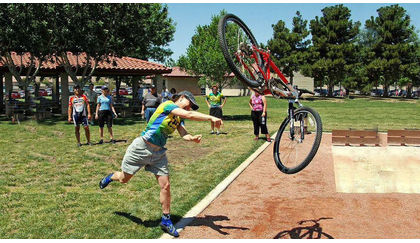
RELATED ARTICLE:
Don't give up on your mountain bike!
Having troubles on the trails? Thinking of giving up? Don't fear, BikeRoar is here to help! READ MORE
